A membranophone is any musical instrument which produces sound primarily by way of a vibrating stretched membrane. It is one of the four main divisions of instruments in the original Hornbostel-Sachs scheme of musical instrument classification.
Gagaku is a type of Japanese classical music that was historically used for imperial court music and dances. Gagaku was developed as court music of the Kyoto Imperial Palace, and its near-current form was established in the Heian period (794–1185) around the 10th century. Today, it is performed by the Board of Ceremonies in the Tokyo Imperial Palace.

The music of Tibet reflects the cultural heritage of the trans-Himalayan region centered in Tibet, but also known wherever ethnic Tibetan groups are found in Nepal, Bhutan, India and further abroad. The religious music of Tibet reflects the profound influence of Tibetan Buddhism on the culture.
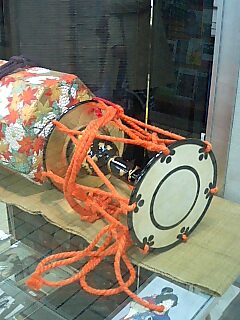
The tsudzumi (鼓) or tsuzumi is a hand drum of Japanese origin. It consists of a wooden body shaped like an hourglass, and it is taut, with two drum heads with cords that can be squeezed or released to increase or decrease the tension of the heads respectively. This mechanism allows the player to raise or lower the pitch of the drum while playing, not unlike the African talking drum and the Indian dhadd.

The janggu or sometimes called seyogo is the most representative drum in traditional Korean music. It consists of an hourglass-shaped body with two heads made from animal skin. The two heads produce sounds of different pitch and timbre, which when played together are believed to represent the harmonious joining of Um and Yang. The janggu is one of the four components of samul nori (사물놀이), alongside the buk (북), jing (징) and kkwaenggwari (꽹과리).

The buk (Korean: 북) is a traditional Korean drum. While the term buk is a native Korean word used as a generic term meaning "drum", it is most often used to refer to a shallow barrel-shaped drum, with a round wooden body that is covered on both ends with animal skin. Buk are categorized as hyeokbu which are instruments made with leather, and has been used for jeongak and folk music.
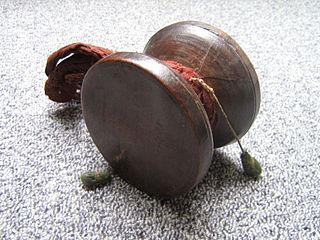
A damaru is a small two-headed drum, used in Hinduism and Tibetan Buddhism. In Hinduism, the damaru is known as the instrument of the deity Shiva, associated with Tantric traditions. It is said to be created by Shiva to produce spiritual sounds by which the whole universe has been created and regulated. In Tibetan Buddhism, the damaru is used as an instrument in meditation practices.

Traditional Korean musical instruments comprise a wide range of string, wind, and percussion instruments. Many traditional Korean musical instruments derive from Chinese musical instruments.
The music of the ancient Mayan courts is described throughout native and Spanish 16th-century texts and is depicted in the art of the Classic Period. The Maya played instruments such as trumpets, flutes, whistles, and drums, and used music to accompany funerals, celebrations, and other rituals. Although no written music has survived, archaeologists have excavated musical instruments and painted and carved depictions of the ancient Maya that show how music was a complex element of societal and religious structure. Most of the music itself disappeared after the dissolution of the Maya courts following the Spanish Conquest. Some Mayan music has prevailed, however, and has been fused with Spanish influences.
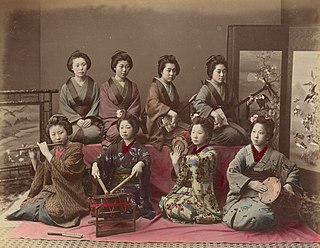
Traditional Japanese musical instruments, known as wagakki (和楽器) in Japanese, are musical instruments used in the traditional folk music of Japan. They comprise a range of string, wind, and percussion instruments.

Hourglass drums are a sub-category of membranophone, or drum, characterized by an hourglass shape. They are also known as waisted drums. Drumheads are attached by laces, which may be squeezed during a performance to alter the pitch. The category also includes pellet drums such as the damaru, although not all pellet drums are hourglass shaped.

Mugo (Korean: 무고) is a jeongjae : a Korean court dance performed using drums. It was created in the Goryeo period. It also practiced in ritual dance of Seungjeonmu. Its name comprises the two words, mu and go literally meaning dance and drum in Korean respectively.

The urumi is a double-headed hourglass drum from the state of Tamil Nadu, South India. Two skin heads are attached to a single hollow, often intricately carved wooden shell. The preferred wood is jackwood, although other woods like rosewood may be used. Both left and right heads are usually made from cow hide that is stretched around a thin metal ring. The outer circumference of each head is perforated with approximately seven to eight holes. The two heads are held in tension by a continuous rope that is woven around the drum in a V-shape pattern. Additional small coils of string or metal are tied around each pair of ropes near the left head. These coils can be slide horizontally along the length of the drum, increasing or decreasing the tension between the heads as necessary. For example, during the monsoon season the drum heads will slacken so much that the instrument becomes unplayable. Using these coils drummers can easily rectify such problems.
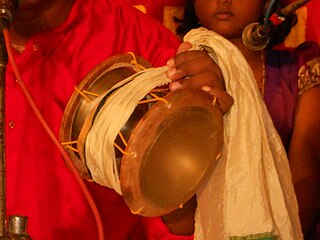
The udukkai, udukai or udukku is a member of the family of membranophone percussion instruments of India and Nepal used in folk music and prayers in Tamil Nadu. The drums are an ancient design of hourglass drums similar to the northern damaru and southern idakka. Its shape is similar to other Indian hourglass drums, having a small snare stretched over one side. They are played with the bare hand, and the pitch may be tered by squeezing the lacing in the middle. It is made of wood or brass and is very portable. It originated in Tamil Nadu as well. Other members in the family include thehuruk, hurkî, hurko, hudko or hudka, utukkai.
Traditional Thai musical instruments are the musical instruments used in the traditional and classical music of Thailand. They comprise a wide range of wind, string, and percussion instruments played by both the Thai majority as well as the nation's ethnic minorities.

Korean drums play an important part in traditional Korean music, ranging from folk music to royal court music. There are a wide variety of shapes and sizes, for use both in accompanying other instruments and in special drumming performances.
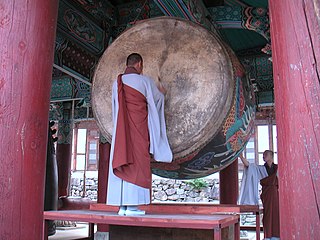
The Korean barrel drum is a shallow, barrel-shaped drum used in several types of Korean music, one of the many traditional Korean drums. This variety of drum has a round wooden body that is covered on both ends with animal skin. They are categorized as hyekbu which are instruments made with leather, and have been used for jeongak and folk music.
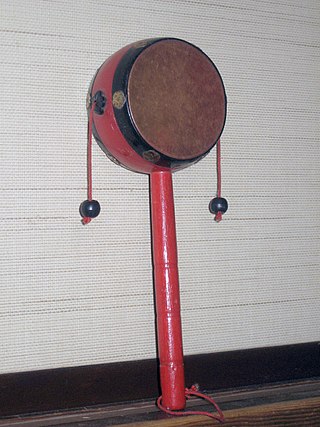
The Den-den daiko is a Japanese hand-held pellet drum, used in Shinto-Buddhist ceremonies, etc.

The dhyāngro is a frame drum played by the jhakri (shamans) of Nepal and India—especially those of the Magars, the Kirati, and the Tamang—as well as by Tibetan Buddhist musicians.














